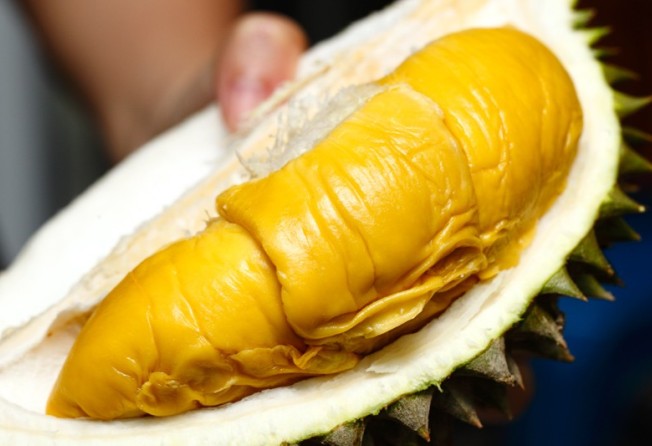
China to buy US$120 million of durians a year from Malaysia as spike in sales expected after green light on export of whole fruits
- Malaysia’s agriculture minister says more Malaysian companies are hoping to obtain permission to export to China, where the fruit is hugely popular
- The Southeast Asian nation’s advantage, according to a durian expert, is that the flavours of fully ripened durian are more in line with Chinese tastes

China just loves Malaysian durians – and with an expected 1,000 tonnes of whole frozen durians from the Southeast Asian nation expected to enter Chinese markets each month, Malaysia is only too happy to indulge that affection.
Durian exports to China are expected to contribute close to 500 million ringgit (US$120 million) to the nation’s total export value annually, said minister of agriculture and agro-based industry Salahuddin Ayub.
Speaking to press as the first shipment of fruits was about to depart to China, the minister said more and more Malaysian companies are hoping to obtain permission to export there.
Also present was Chinese ambassador to Malaysia Bai Tian, who said there were “300-400 million mid-income customers” in China who were “all waiting for the best of the durians” to arrive.
Previously, Malaysia was only allowed to ship frozen durian pulp and paste to China, but a recent agreement has given whole fruits the green light – putting the country in direct competition with Thailand, which until recently was the only country allowed to do so.
The durian, which has a thorny skin that is carved open to reveal handfuls of creamy, custard-like fruit, is a polarising delicacy. While it is popular in Asia, some are unable to stomach its pungent fragrance.

Malaysia’s advantage, said durian expert Lim Chin Kee, is that the flavours of ripened durian are more in line with Chinese tastes.
Pricey variants such as Musang King – or Mao Shan Wang – durians are the one of most widely sought after in China due to its sticky, creamy texture and rich bittersweet flavour, and are expected to be sold there for US$29 per kilogram.
“Malaysia’s production is low compared with Thailand or Indonesia. Thailand even exports [to Malaysia],” Lim said. “But the Chinese are willing to pay for quality and premium price, for variants like Musang King. China prefers Malaysia durians because they also like the fully ripe fruit.”
Unlike Malaysia, Thai exporters tend to send out whole fruit that ripens in transit, according to political economist Khor Yu Leng, who said Malaysia’s new-found approval for whole frozen fruit exports would be the key for entry into the “coveted China market”.
Malaysia last year exported 235.6 metric tonnes of durian pulp and paste, worth 9.44 million ringgit, to China. More recently, Chinese e-commerce giant JD.com reported selling over 12,000 whole frozen fruits in just 10 hours.
Local producers, however, will be able to meet China’s demands as well as fulfil the demands of the domestic and regional market, said agriculture minister Salahuddin.

“Negotiations with China in the past few years have resulted in the opening of more commercial durian farms, thus giving a boost to production,” he said, adding that production was expected to keep increasing.
In 2018, Malaysia’s total durian production rose to 341,000 tonnes, up from 211,000 tonnes the previous year. While Malaysia exports just a small percentage of the fruit it produces, China’s appetite for durian – which Chinese people even eat on pizza or in hotpot – has seen Malaysia keen to cash in on exporting the “king of fruits”.
The opening up of the market for durian may even, say experts, take some of the emphasis off oil palms, one of Malaysia’s key bulk agro-commodities along with rubber. The income per hectare for Musang King durians could, said economist Khor, be nearly nine times that of oil palms.
“The focus on fruits is more recent, driven by the realisation that oil palms are not delivering enough income, especially for the aspirations of the younger generation of rural folk. The move to durians is the start of the journey for Malaysia and its farmers to seek higher value-add incomes,” she said.
According to durian expert Lim, some oil palm plantations have already started converting patches of land for durian production.

“If it goes well, they will apportion bigger parcels of land. For now, trial patches are between 100 to 300 hectares. Oil palms are now not so promising,” he said, adding that Malaysians could still afford the current price of durians despite Chinese demand.
“Maybe it will be harder in the off season, but during peak season the price will still drop and most people can afford to eat durian. If Musang King is too expensive, there are other varieties to try,” said Lim.
His personal favourite, he said, was the lighter, more velvety D160, also called Tekka or Musang Queen.
Fears that Chinese demand will drive up prices are real – last year, deputy agriculture minister Sim Tze Tzin had to assure fellow lawmakers in a parliamentary reply that China only bought 5.8 per cent of total durian production, although this was before the limits on frozen whole fruits were lifted.
“We have enough supply currently for even our neighbouring countries,” said agriculture minister Salahuddin.
Khor, the economist, said freezing durians could mark an important change and a solution to any potential future shortages.
“Assuming defrosted durians are well accepted by locals, and if traders can play at the margins with stocks, local price fluxes could be moderated if the eating season can be extended,” she said.
“But of course durian prices can be confusing. It would be useful to have better transparency on durian type, fruit grading, and price.”